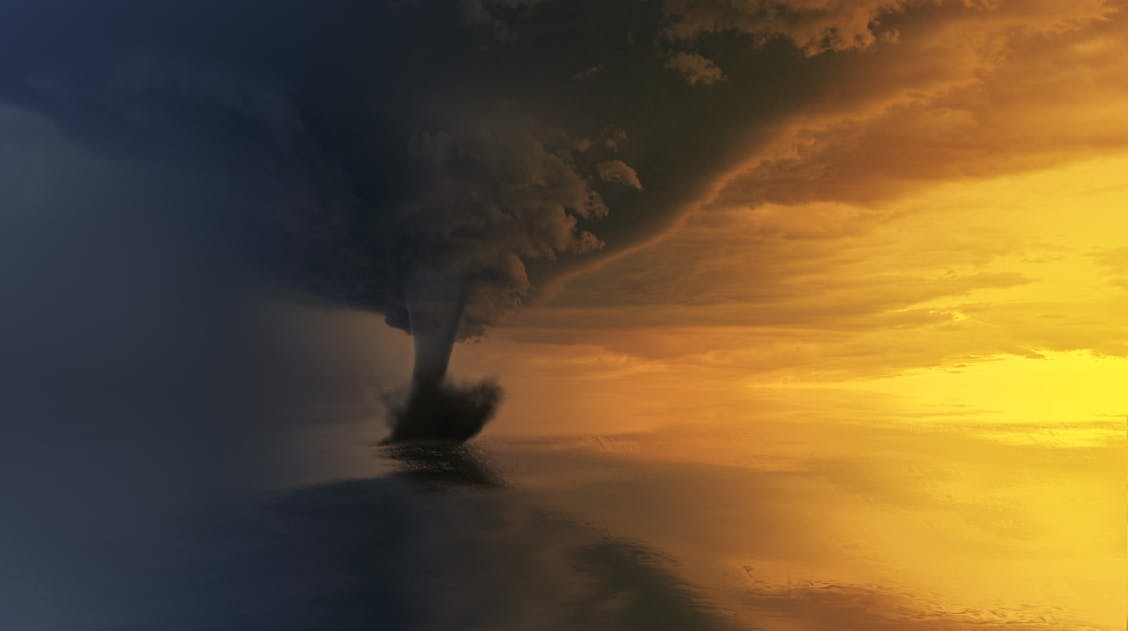
Monitoring the Impact of Hurricanes on Coral Reefs in the Carribbean
Hurricanes in the Atlantic Ocean are common, with the hurricane season in the Atlantic running from June to November. However, increases in the sea surface temperature caused by global warming are increasing the intensity of hurricanes in the Caribbean. Since March 2023, sea surface temperatures have been at record highs. The temperatures increased so much that the North Atlantic experienced a marine heatwave throughout June 2023. Hurricanes extract more energy from a warm ocean and more water vapor, resulting in increased wind speed and rainfall. Globally, as ocean temperatures continue to rise as well as sea levels, hurricanes are predicted to become more destructive and costly to both human life and ecosystems such as coral reefs.
A study recently published in Sustainability investigates the impact that storms and hurricanes are having on endangered species of coral and the overall damage they’re causing to coral reef ecosystems in the Caribbean. This article explores the study and how hurricanes are impacting ocean ecosystems.
What are hurricanes?
Hurricanes are a type of storm known as tropical cyclones; they form over tropical or subtropical waters. Tropical cyclones are defined by the National Oceanic and Atmospheric Administration (NOAA) as:
“a rotating low-pressure weather system that has organised thunderstorms but no fronts (a boundary separating two air masses of different densities)”
The storm takes on hurricane status once it reaches sustained maximum winds of 74 mph or more. Hurricanes are graded based on their intensity using the Saffir Simpson Hurricane Wind Scale, which grades them 1–5 based on their maximum wind speed.
Because of the increase in ocean temperatures seen in the Atlantic Ocean, it’s suggested that the Caribbean will experience higher-grade hurricanes. The NOAA has predicted that the 2024 Atlantic hurricane season will see 17–25 named storms with winds over 39 mph or higher. Additionally, they predict that from 8 to 13 of these storms will reach hurricane status with winds of 74 mph or over. Furthermore, they suggest that from 4 to 7 of these hurricanes will have a high grade of 3–5.
These predictions could have devastating consequences for ocean ecosystems and the life forces in these habitats, such as coral reefs.
Impact of hurricanes on the Caribbean
Hurricanes Irma and María inflicted serious damage on the Caribbean. Puerto Rico sustained a lot of damage from both hurricanes, resulting in the loss of life and the devastation of coral reefs.
Hurricane María resulted in extensive damage caused by extreme rainfall in Puerto Rico. The greatest 24-hour rain intensities among all the storms recorded in the area triggered numerous landslides. This resulted in hundreds of casualties and serious damage to agriculture and infrastructure. Both hurricanes were recorded to have sustained winds over 167 mph.
The speed of the winds resulted in the ocean building strong waves, which were reported to cause large amounts of damage to coral reefs.
The importance of coral reefs
Coral reefs are the heart of many ocean ecosystems. They provide a habitat for diverse marine species, including plants and organisms. Additionally, they are a safe sanctuary for many species, providing protection and food sources. It’s estimated that about 25% of ocean fish depend on healthy coral reefs. They support more species per unit than any other marine environment. This includes 4,000 species of fish, 800 species of hard corals, and hundreds of different species. In addition, they are suggested to support millions of undiscovered species of organisms.
Examples of this include photosynthetic algae known as zooxanthellae, which live in the tissues of reef-building corals. They have a symbiotic relationship, which is a partnership where both species benefit from each other.
The coral provides the algae protection and compounds required for it to undergo photosynthesis. In exchange, the algae supply the coral with oxygen as well as the products of photosynthesis, including glucose, glycerol, and amino acids. Moreover, coral uses these products to produce a range of nutrients. Additionally, zooxanthellae give some corals their distinctive colouring.
Coral reefs protect coastlines against storms and erosion. They can buffer against 97% of the energy generated from storms, waves, and floods. Furthermore, they have multiple benefits for local communities and the economy. Billions of people depend on the reefs for jobs such as fishing and tourism accumulating millions of dollars for various businesses.
Impact of climate change on coral reefs
Climate change can have a huge impact on the health and well-being of coral reefs. The increase in ocean temperatures influenced by global warming is already causing detrimental effects.
The United Nations (UN) estimates that 60% of the world’s marine ecosystems have already been degraded or are being used unsustainably. Furthermore, they warn that a warming of 1.5 °C threatens to destroy 70–90% of coral reefs. A more significant rise of 2 °C could result in irreversible damage, culminating in nearly 100% loss.
Corals are sensitive to changes in their environment – any changes in temperature, light, or nutrients can cause them to become stressed. When stressed, they expel zooxanthellae algae, their main source of food, causing them to turn white. This is also known as coral bleaching, which leaves the coral vulnerable and more susceptible to disease. Indirectly, hurricanes and storms can cause coral bleaching via storm-generated precipitation, which can leech pollutants into the ocean. Furthermore, hurricanes can directly cause damage via mechanical stress generated by wave action.
Given their environmental and economic importance, researchers from Puerto Rico studied the impact stronger hurricanes and climate change have on endangered coral species in the Caribbean.
Monitoring the impact of hurricanes on coral reefs
The researchers monitored the health of six endangered coral species: Staghorn coral (A. cervicornis), Star corals (Orbicella annularis, O. faveolata, and O. franksi), Pillar coral (Dendrogyra cylindrus) and Elkhorn coral (Acropora palmata) across 15 sites in the wider Caribbean. This included Puerto Rico, before and after the impacts of category five hurricanes Irma and María in 2017. Furthermore, they monitored the susceptibility of the coral to hurricane damage depending on depths of <5 m, 5–10 m, and 10–15 m.
They assessed the damage to the coral reefs caused by hurricanes by characterising the damage into four main types:
- Mechanical destruction of the reef framework leading to extensive rubble fields.
- Colony fragmentation and dislodgement.
- Abrasion by sediment bedload.
- Burial by displaced sediments and rubble.
Additionally, the researchers investigated the frequency and intensity of tropical storms and hurricanes across the northeastern Caribbean.
Results
Hurricanes Irma and María caused devastating damage in northeastern Puerto Rico. The study identified that they caused significant damage to all five endangered coral species at all locations and depths.
However, they identified that shallower reefs were more susceptible to damage as they were more exposed to wave action. Because of this, the researchers acknowledged that certain species were more susceptible to damage. For example, branching species of coral, such as Staghorn Coral (A. cervicornis), are commonly found in shallow reefs, and because of this, they sustain substantial and widespread damage.
The researchers also identified that foliose species showed from moderate to minimal vulnerability to wave action. Because of this, sustained moderate mechanical damage. Additionally, they also identified from moderate to high localised damage to small-sized encrusting and massive morphotypes due to sediment bedload and burial by rubble.
Furthermore, they identified that large-sized massive and boulder corals were more susceptible to sediment bedload and burial by displaced rubble fields as well as a post-hurricane white plague-like syndrome.
White plague is a common disease that affects coral. It targets the tissue of the coral, causing rapid tissue loss. This rapid loss of tissue exposes their white skeletons, which give them their telltale features.
The researchers identified a mean 35% decline in Acropora palmata live cover, 79% in A. cervicornis, 12% in Orbicella annularis, 7% in O. faveolata, 12% in O. franksi, and 96% in Dendrogyra cylindrus. This is a substantial decline in endangered species of coral, which poses a huge threat to ocean ecosystems.
Protecting coral reefs from hurricanes
Climate change is a threat to the ocean ecosystem. It’s expected to cause an influx of stronger hurricanes in the tropical Atlantic. The researchers state that we must act now to protect and preserve coral reefs.
They suggest that conservation methods should include safeguarding coral reefs, reducing global greenhouse gas emissions, adopting sustainable fishing practices, and implementing ecological restoration programs. Additionally, they suggest that supporting reef recovery is vital for vulnerable coral species. In addition, sustained efforts need to be made in coral propagation and low-tech reef rehabilitation.
This includes supporting the reconstruction of damaged coral reefs and the rejuvenation of these ecosystems. This not only restores habitats but also protects them against future hurricanes by improving their health and strength and enhancing attenuation.
If you’re interested in reading more about the restoration and conservation of ecosystems and want to submit your research on the subject, please see the Topic: Conservation and Management of Marine Ecosystems










